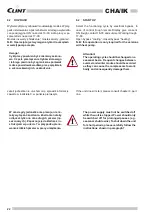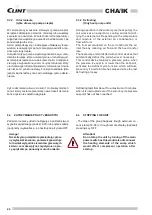
31
CHA/IK
9.1.1 Monthly controls
- Make sure the terminals in the electrical panel and in
the compressor terminal board are well tightened.
- Check the fixed and mobile contacts of the contactors
and replace them if they are worn.
- Make sure no oil is leaking from the compressor.
- Make sure that no water is leaking from the water
circuit.
- Drain the water circuit.
- Make sure the differential water presure switch works
correctly.
- Check the heating elements in the compressor
sump.
- Clean the metal filters in the water pipes.
- Clean the finned coil (and the relative metal filters, if
present), by directing a jet of compressed air in the
opposite direction from that of the air flow. If the filters
are very clogged, use a jet of water instead.
- Check that the unit doesn’t make any unusual nois -
es.
9.1.2 Four-monthly controls
- Make sure the fans are fixed, balanced and in good
condition.
9.2
REPAIRING THE REFRIGERANT CIRCUIT
These repairs may only be made by spe-
cialised staff using the normal techniques
for chillers that make use of halogen
fluids
as refrigerants.
9.3
TOPPING UP THE REFRIGERANT
This operation should only be carried out after identify -
ing and repairing the leak.
For units using R410A or no more than
two top ups are allowed. If another top up
is required the refrigerant circuit must be
completely emptied and
then
filled
with new
refrigerant.
9.1.1
Przeglądy comiesięczne
- Sprawdź czy zaciski w rozdzielnicy i na listwie zacis-
kowej sprężarki są dobrze zaciśnięte.
- Sprawdź stałe i ruchome złącza styczników i wymień
je w razie ich zużycia.
- Upewnij się, że olej nie wycieka ze sprężarki.
- Upewnij się, że woda nie wycieka z obiegu wodnego.
- Spuść wodę z obiegu wodnego.
- Upewnij się, że presostat różnicowy wody pracuje
poprawnie.
- Sprawdź elementy grzewcze karteru sprężarki.
- Oczyść filtry metalowe instalacji wodnej.
- Oczyść lamele (i odpowiednie filtry metaliowe jeżeli
zostały zamontowane) kierując na nie strumień sprę-
żonego powietrza, w przeciwną stronę do wylotu po-
wietrza. Jeżeli filtry są bardzo zabrudzone, umyj je
strumieniem wody.
- Sprawdź czy urządzenie nie generuje nieprawidłowych
dźwięków.
9.1.2
Przeglądy co cztery miesiące
- Upewnij się, że wentylatory są mocno zamocowane,
wyważone i ich stan techniczny jest dobry.
9.2
NAPRAWA OBIEGU CHŁODNICZEGO
Czynności naprawcze mogą być wykonywane
wyłącznie przez personel wykwalifikowany
w zakresie technik naprawy urządzeń chłod-
niczych, wykorzystujących ciecze z grupy
chlorowców jako czynnik chłodniczy.
9.3
NAPEŁNIANIE CZYNNIKA
Czynność ta powinna być wykonana dopiero po wykry-
ciu i usunięciu źródła wycieku.
Dla urządzeń na czynnik R410A dopuszczalne
jest maksymalnie dwukrotne napełnianie
układu dodatkowym czynnikiem. Jeżeli ko-
nieczne jest kolejne napełnienie, obieg chłod-
niczy należy całkowicie opróżnić i napełnić
nowym czynnikiem.


































